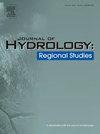Optimizing flood resilience in China’s mountainous areas: Design flood estimation using advanced machine learning techniques
IF 5
2区 地球科学
Q1 WATER RESOURCES
引用次数: 0
Abstract
Study region
China
Study focus
We developed machine learning (ML) models for design flood estimation in mountainous catchments (≤ 500 km²) across China. This process considered different ML algorithms (random forest, extreme gradient boosting, and support vector regression), model scopes (nation and hydrological zones), and feature input sets (1–14 features) to optimize model development strategies.
New hydrological insights for the region
Based on estimation performance and hyperparameter tuning efficiency, random forest was found to be the optimal algorithm. The optimal model scope resulted in five distinct models: a single lumped model encompassing six eastern zones and four separate zonal models for the western zones. Considering both accuracy and efficiency, the optimal number of input features ranged from 5 to 14 for different models. High estimation accuracy was observed in the Qinba-Dabie North, Southeast, Southwest, and Yunnan-Tibet Zone, with average RMSE, R², MQE, and QR ranging from 55.90 to 103.97, 0.83–0.93, 45.62–65.77 %, and 55.90–60.98 %, respectively, for the test set across different return periods. The remaining zones exhibited moderate accuracy, with the Northwest Basin Zone demonstrating particularly low accuracy due to fewer catchments. Notably, catchments with areas > 100 km² demonstrated higher estimation accuracy, with an average 60 % reduction in MQE and a 30 % increase in QR compared to catchments of all sizes. This study provides crucial reference and data support for national flash flood prevention efforts.
优化中国山区的抗洪能力:利用先进的机器学习技术设计洪水估算
我们开发了机器学习(ML)模型,用于估计中国各地山区集水区(≤500 km²)的设计洪水。该过程考虑了不同的ML算法(随机森林、极端梯度增强和支持向量回归)、模型范围(国家和水文带)和特征输入集(1-14个特征)来优化模型开发策略。基于估计性能和超参数调整效率,发现随机森林算法是最优算法。最优的模型范围产生了五个不同的模型:一个包含六个东部区域的单一集总模型和四个独立的西部区域模型。考虑到准确率和效率,对于不同的模型,最优的输入特征个数在5 ~ 14之间。在秦巴-大别北部、东南、西南和云藏地区,各回归期的平均RMSE、R²、MQE和QR值分别为55.90 ~ 103.97、0.83 ~ 0.93、45.62 ~ 65.77 %和55.90 ~ 60.98 %,估计精度较高。其余区域精度中等,西北盆地区域由于集水区较少,精度特别低。值得注意的是,与所有规模的集水区相比,面积为>; 100 km²的集水区显示出更高的估计精度,MQE平均减少60 %,QR平均增加30 %。本研究为国家防汛减灾工作提供了重要的参考和数据支持。
本文章由计算机程序翻译,如有差异,请以英文原文为准。
求助全文
约1分钟内获得全文
求助全文
来源期刊

Journal of Hydrology-Regional Studies
Earth and Planetary Sciences-Earth and Planetary Sciences (miscellaneous)
CiteScore
6.70
自引率
8.50%
发文量
284
审稿时长
60 days
期刊介绍:
Journal of Hydrology: Regional Studies publishes original research papers enhancing the science of hydrology and aiming at region-specific problems, past and future conditions, analysis, review and solutions. The journal particularly welcomes research papers that deliver new insights into region-specific hydrological processes and responses to changing conditions, as well as contributions that incorporate interdisciplinarity and translational science.
 求助内容:
求助内容: 应助结果提醒方式:
应助结果提醒方式:


